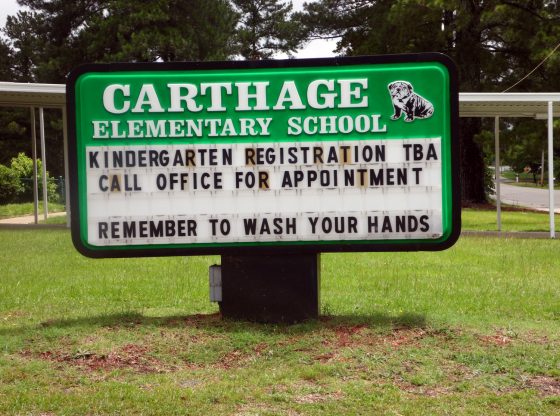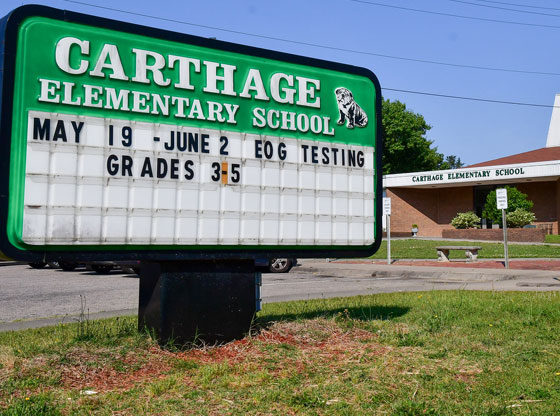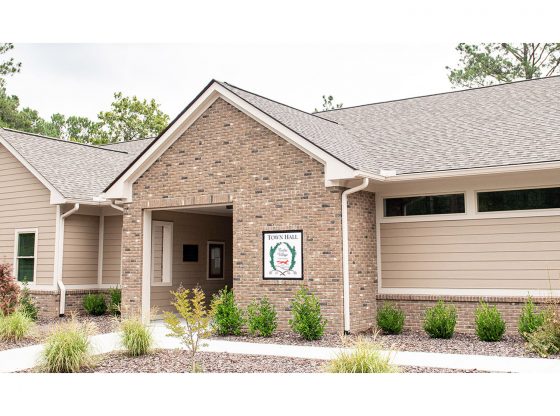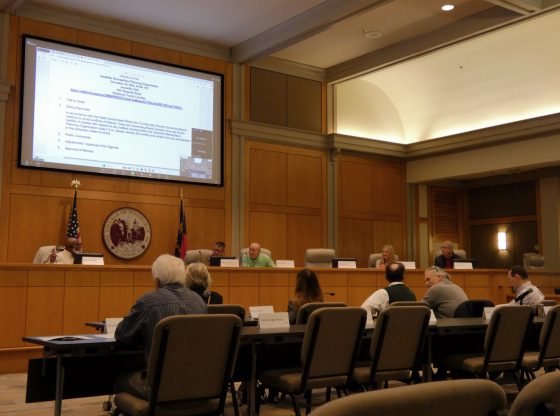Moore County Schools Achieves Gains in State Accountability Measures in 2016-2017
The district’s graduation rate increased to 91 percent; 3.2 percent higher than last year and 4.5 percent higher than the state average, which at 86.5 percent is a record high for the state for the 12th consecutive year.
Students earned 1,310 college credits while still in high school.
CTE credentials earned in 2016-2017 totaled 801 as compared to 475 earned in 2015-2016.
Ten schools earned a “B” grade, three more than last year.
All 2016-2017 EOG and EOC scores were above the state average.
Moore County Schools continues to make gains on most measures of student learning, according to school accountability data released on September 7, 2017, by the North Carolina Department of Public Instruction (NCDPI) as part of its READY accountability initiative.
The 2016-2017 school year was the fifth year of the state’s READY accountability initiative, which is based on standards set on grade level proficiency and career and college readiness, and the fourth year for which public and charter schools receive a letter grade based on a school’s achievement score (80 percent) and students’ academic growth over one year (20 percent).
Overall, of the 20 schools within Moore County Schools that are assessed, 10 received a B grade, up three from 2015-2016 and the highest number since the initiation of the school performance grade measurement. Seven schools received a C grade, three less than 2015-2016. Three schools received a D grade, the same number as 2015-2016. No school received a F grade.
“While there remains more to learning than just test scores and other accountability measures, I am very happy for our students, teachers and principals. The continued improvement in our state accountability outcomes validates everyone’s hard work and attention to detail,” said Moore County Schools Superintendent Bob Grimesey. “In just four years, we have nearly doubled the number of our ‘B’ schools from six to 10, and all three of our high schools are now graded ‘B.’ It remains my privilege to serve with such dedicated teachers and principals who are building a solid foundation for academic success for student across all of our grade levels.”
Schools receiving a B performance grade were: Carthage Elementary, Highfalls Elementary, New Century Middle, North Moore High, Pinecrest High, Pinehurst Elementary, Union Pines High, West End Elementary, West Pine Elementary and West Pine Middle. Schools receiving a C performance grade were: Cameron Elementary, Crain’s Creek Middle, Elise Middle, Sandhills Farm Life, Southern Pines Elementary, Vass-Lakeview Elementary and Westmoore Elementary. Schools receiving a D performance grade were: Aberdeen Elementary, Robbins Elementary and Southern Middle. Schools that moved from C to B between the 2015-16 and 2016-17 terms were: Carthage Elementary, Highfalls Elementary, North Moore High and West End Elementary. One school dropped from B to C from 2015-16 to 2016-17: Sandhills Farm Life.
Southern Pines Primary and Aberdeen Primary are not required to take state accountability tests. Although students at the Community Learning Center at Pinckney are assessed, the state uses a different accountability model for alternative schools, in which Pinckney excelled being designated at “progressing,” the highest mark for alternative schools in North Carolina.
Elementary and middle schools’ performance grades are based on proficiency scores in reading and math in grades 3 through 8, and in science in grades 5 and 8 in what are referred to as end-of-grade (EOG) exams. High school grades are based on results from end-of-course (EOC) exams in English II, Math I and Biology, as well as other performance indicators such as the cohort graduation rate and the percentage of career and technical education graduates who earn a Silver Certificate or higher on the ACT WorkKeys assessment.
Moore County Schools’ four-year high school cohort graduation rate for the class of 2017 was 91.0 percent and continues to remain above the state average of 86.5 percent – a North Carolina record graduation rate for a 12th consecutive year. For student proficiency on the ACT WorkKeys assessment, 78.9 percent of the class of 2017 achieved the Silver level of proficiency, which was the same level as 2016 but a marked increase from 75.9 percent in 2015.
EOG and EOC exams measure proficiency on two scales: grade level proficient (GLP) and college and career readiness (CCR). District-wide results in reading for grades 3 through 8 found that 62.6 percent were grade level proficient, 1.4 percentage points higher than 2015-16, and 5.1 percentage points above the state average of 57.5 percent. For math grades 3 through 8, 55.7 percent demonstrated grade level proficiency, a slight dip of 0.6 percentage points but slightly above the state average of 55.4 percent. Grade level proficiency in science grades 5 and 8 was 75.5 percent, an increase of 1.3 percentage points over 74.2 percent in 2015-16, and above the statewide average of 72.8 percent.
For the high school EOC exams student grade level proficiency in English II increased from 64.4 percent in 2015-16 to 65.6 percent in 2016-17, and Math I increased from 64.3 percent in 2015-16 to 65.3 percent in 2016-17. Grade level proficiency for Biology made a significant increase 53.1 percent in 2015-16 to 71.8 in 2016-17, which is 15.7 percentage points above the state average of 56.1 percent. All 2016-2017 EOG and EOC scores were above the state average.
More information about accountability measurements and school performance grades for districts throughout the state can be found on the North Carolina Department of Public Instruction’s website at www.ncpublicschools.org/accountability/reporting/.
In the fourth year of the state’s A-F grading system, the percentage of A or B schools (35.8 percent) continued to climb and the percentage of D and F schools (22.6 percent) fell compared to the 2015-16 school year, according to school accountability data released today to the State Board of Education. In addition, the state’s four-year high school cohort graduation rate continued its upward trend, moving to 86.5 percent from the 85.9 percent figure from the 2015-16 school year. North Carolina’s public schools have set a record graduation rate for a 12th consecutive year.
School Performance Grades are based 80 percent on the school’s achievement score and 20 percent on students’ academic growth. The only exception to this is if a school meets expected growth but inclusion of the school’s growth reduces the school’s performance score and grade.
A majority (56.5 percent) of the state’s high schools earned a grade of B or better. On the growth metric, elementary schools were more likely to meet growth than middle or high schools; 80.3 percent of elementary schools met or exceeded growth. Elementary and middle schools’ performance grades are based on test scores alone, while high school grades are based on test results, graduation rates, and indicators of students’ readiness for college or a career.
Growth data for the 2,531 schools rated showed little change from the previous year, with the percentage of schools meeting or exceeding growth targets changing from 73.6 percent in 2015-16 to 73.7 percent in 2016-17. The proportion of schools not meeting growth dropped slightly as well. Growth is measured by a statistical model that compares each student’s predicted test score, based on past performance, against his or her actual result.
“It’s great news that the top-line trends are in the right direction. We can all be proud, for instance, that most schools meet or exceed growth,” said Mark Johnson, state superintendent of public schools. “But deeper into the data, the results show stubborn concerns that call out for innovative approaches. It is with innovation and personalized learning that we can transform incremental progress into generalized success.”
School grades continue to correlate strongly with the poverty levels of schools. Among all schools in 2016-17 that received a D or F, 92.9 percent had enrollments with at least 50 percent of students from low-income families. Conversely, among schools that received at least a B, 72.5 percent had enrollments with less than 50 percent of students from low-income families.
“The graduation rate is at an all-time high, and the school letter grades continue to give parents an easy-to-understand way to chart progress and compare schools,” said Bill Cobey, chairman of the State Board of Education. “Parents should use the results we released today to learn more about how their children’s schools are doing and to become more involved in helping schools and students succeed.”
Low-performing schools are identified annually as those that receive a School Performance Grade of D or F and do not exceed growth. Low-performing districts are districts where the majority of schools received a School Performance Grade and have been identified as low performing. For 2016-17, 505 schools were identified as low performing and 11 districts were low performing, both up from 489 schools and 10 districts in 2015-16. The number of recurring low-performing schools increased from 415 in 2015-16 to 468 in 2016-17.
NCDPI will continue to serve and support low-performing districts and schools through the creation of a new division combining the Educator Effectiveness and the District and School Transformation divisions.
In 2016, the North Carolina General Assembly designed and launched a new strategy focused on improving student outcomes in low-performing schools. The effort, called the Innovative School District (ISD), provides that the State Board of Education will select schools this fall, based on the recommendation of the ISD Superintendent, to be transferred into this statewide school district, which will partner with local schools, districts and communities to engage innovative strategies to drive student achievement.
Once selected, schools in the ISD will be operated by qualified charter or education management organizations for at least five years, with the first schools joining the new district for the 2018-19 school year. To be considered for the ISD, a low-performing school must have a school performance score in the lowest 5 percent of all schools in the state. The list of schools the State Board of Education can consider for the ISD is posted online.
2016-17 State, District and School Level Data Results.
ncpublicschools.org



















